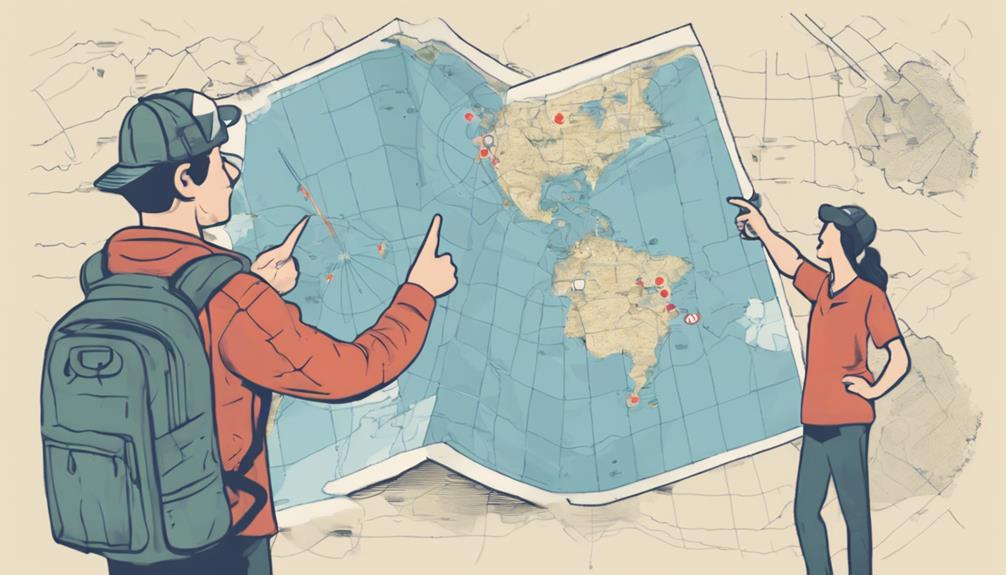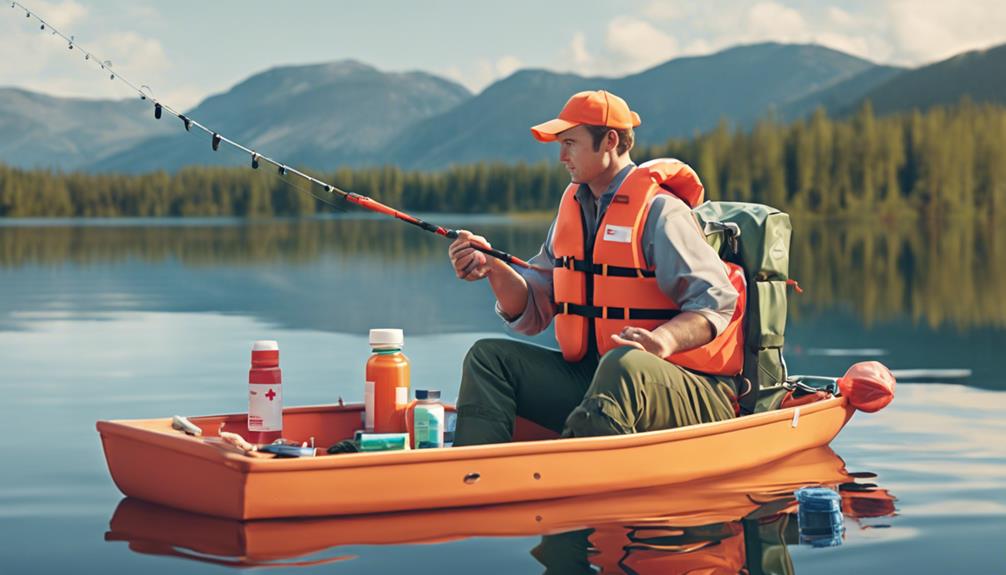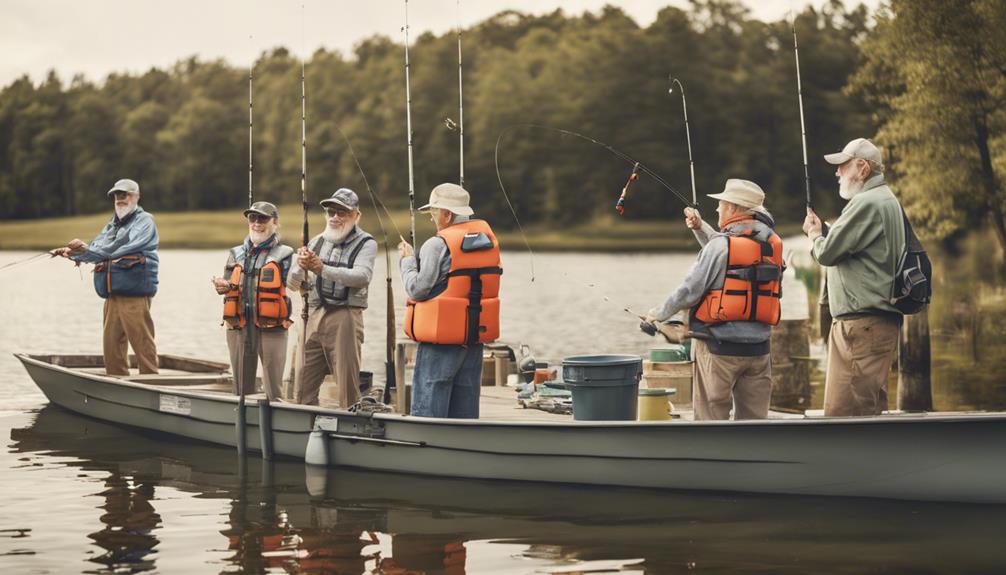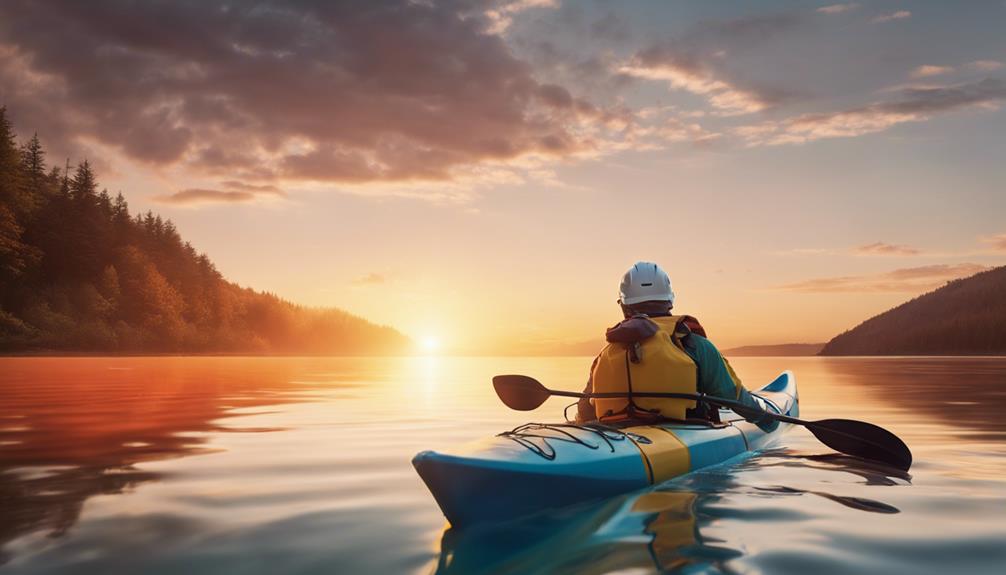When it comes to practicing safe lake fishing, think of it as navigating uncharted waters. The thrill of the catch can quickly turn sour if safety measures are overlooked.
From understanding the ever-changing lake conditions to communicating your plans effectively, each step is crucial.
So, before you cast your line, ensure you have the knowledge and tools to make your fishing experience not only successful but also safe.
Understanding Lake Conditions
To ensure a safe fishing experience, understand the current conditions of the lake before casting your line. Start by observing the water clarity and temperature. Clear water makes it easier for fish to see your bait, while knowing the temperature can help you determine where the fish might be located. Warmer water near the surface often attracts fish seeking food or comfortable conditions, while colder water may push them to deeper areas.
Next, pay attention to the wind direction and speed. Wind plays a crucial role in lake fishing as it affects the movement of both the water and the fish. Fish tend to swim with the current, so casting your line against the wind might yield better results. Additionally, wind can impact your casting accuracy and the overall stability of your boat. Understanding how wind influences the lake conditions can help you position yourself strategically for a successful fishing trip.
Checking Local Fishing Regulations
Before you head out for your next fishing adventure, make sure to familiarize yourself with the local fishing regulations in the area. Checking the permit requirements is crucial to ensure you're in compliance with the law. Some areas may require specific permits or licenses for fishing, so it's essential to obtain the necessary documentation before casting your line. Failure to adhere to permit regulations can result in fines or penalties, putting a damper on your fishing trip.
Additionally, be aware of any seasonal restrictions that may be in place. Certain fish species have designated seasons when they can be caught, and there may be restrictions on the size or quantity of fish you're allowed to keep during different times of the year. By understanding these seasonal regulations, you can help protect the local fish population and ensure sustainable fishing practices.
It's also important to be mindful of any catch and release guidelines that may be in effect. Some areas have specific rules regarding releasing certain fish species back into the water to help maintain healthy fish populations. By familiarizing yourself with these regulations, you can do your part in preserving the aquatic ecosystem for future generations of anglers. Remember, respecting and following local fishing regulations isn't only a legal obligation but also a way to contribute to the conservation of the environment.
Using Proper Safety Gear
Ensure you have the appropriate safety gear before embarking on your lake fishing excursion. Proper safety gear is essential for a safe and enjoyable fishing experience. Here are some key points to consider:
- Gear Maintenance and Safety Tips
- Regularly inspect and maintain your safety gear to ensure it's in good working condition.
- Follow manufacturer guidelines for maintenance to prolong the life of your gear.
- Always wear a properly fitting life jacket to stay safe while out on the water.
- Emergency Preparedness and First Aid
- Pack a first aid kit that includes essentials such as bandages, antiseptic wipes, and pain relievers.
- Familiarize yourself with basic first aid procedures in case of minor injuries while fishing.
- Have a plan in place for emergencies, including knowing how to call for help and having emergency contact information readily available.
Handling Fish Properly
Inspect your catch for any signs of injury or stress before handling it to ensure the fish's well-being. Handling fish properly is crucial for fish conservation and ethical angling practices. When holding a fish, make sure your hands are wet to protect its slimy outer layer. Grasp the fish gently but securely, supporting its body to avoid unnecessary strain on its internal organs. Avoid squeezing the fish tightly or touching its gills, as this can harm the fish and reduce its chance of survival if released.
Fish release is an essential aspect of ethical angling. If you plan to release the fish, do so quickly and with care. Minimize the time the fish spends out of the water to prevent stress and exhaustion. Always follow catch limits and regulations to protect fish populations and ensure sustainable angling practices. If the fish isn't going to be kept, release it gently back into the water, allowing it to swim away on its own.
Remember that proper handling of fish not only promotes fish conservation but also contributes to the enjoyment of angling for years to come. By practicing ethical angling techniques and respecting catch limits, you can help maintain healthy fish populations in lakes and ensure a rewarding fishing experience for yourself and others.
Avoiding Crowded Areas
To enhance your fishing experience and increase your chances of catching fish, consider steering clear of crowded areas. Finding solitude while fishing can be a rewarding experience, allowing you to connect with nature and enjoy a peaceful environment.
Here are some tips to help you avoid crowded fishing spots:
- Explore Off-the-Beaten-Path Locations: Venture away from popular fishing spots and explore less frequented areas of the lake. These hidden gems often offer better fishing opportunities and a more serene atmosphere.
- Fish During Off-Peak Hours: Plan your fishing trips during weekdays or early mornings when fewer people are likely to be out on the water. This strategic planning can help you avoid the crowds and have a more enjoyable fishing experience.
- Utilize Technology: Use fishing apps or websites to research the lake and identify secluded areas that are less populated. By leveraging technology, you can find hidden fishing spots that offer tranquility and better chances of catching fish.
Being Aware of Weather Changes
When fishing on a lake, staying alert to weather changes can significantly impact your safety and fishing success. Emergency preparedness is key when it comes to unpredictable weather conditions. Before heading out, check the weather forecast and keep an eye on any updates throughout your fishing trip. Pack essential items like a waterproof jacket, extra clothing, a first aid kit, and a flashlight in case of unexpected storms or temperature drops. Being prepared can make a huge difference in ensuring your well-being during adverse weather conditions.
In addition to emergency preparedness, actively monitoring the weather while you're fishing is crucial for your safety. Keep an eye on the sky for any darkening clouds, sudden temperature changes, or increasing winds, as these could be signs of an approaching storm. If you notice any of these indicators, it's important to take immediate safety precautions. Move to shore quickly and seek shelter in a sturdy building or a vehicle. Avoid open spaces, tall trees, or bodies of water during a storm to reduce the risk of lightning strikes. By staying aware of weather changes and acting swiftly when needed, you can enjoy a safer and more successful fishing experience on the lake.
Communicating Your Plans

Stay proactive by sharing your fishing plans with a reliable contact to ensure your safety while out on the lake. This simple step can make a significant difference in case of emergencies.
Here's how you can effectively communicate your plans:
- Informing Family: Let your family members or close friends know where you intend to fish, how long you plan to be out on the lake, and when they should expect you back. Providing these details can help them raise the alarm if you don't return as scheduled.
- Alerting Authorities: Consider informing local authorities or the coast guard about your fishing expedition. They can keep an eye out for you and provide assistance if needed. Having them aware of your plans adds an extra layer of safety.
- Using Technology: Leverage technology by sharing your GPS location with your contacts. Many mobile apps allow you to share real-time location updates, ensuring that someone can track your whereabouts.
Practicing Leave No Trace
Practicing Leave No Trace is essential for maintaining the pristine environment of the lake while fishing. When you engage in ethical angling practices, you ensure minimal impact on the natural surroundings, allowing both the ecosystem and other visitors to enjoy the lake for years to come.
To begin with, always make sure to pack out everything you bring in. This means any trash, leftover bait, or fishing line should be properly disposed of in designated areas. Leaving behind any waste can harm wildlife and disrupt the balance of the lake's ecosystem. Additionally, avoid using live bait from other bodies of water to prevent introducing non-native species that could threaten the local aquatic life.
Furthermore, be mindful of where you set up your fishing spot. Avoid trampling on vegetation or disturbing nesting areas of wildlife. By treading lightly and respecting the natural habitats around the lake, you contribute to the preservation of the environment. Remember, the goal is to enjoy fishing while leaving no trace of your presence behind.
Frequently Asked Questions
How Can I Determine the Best Time of Day to Fish on a Lake?
To figure out the best time to fish on a lake, consider weather patterns and fish behavior.
Also, pay attention to moon phases for increased fishing success.
By observing these factors, you can determine when the fish are most active and likely to bite.
This will help you plan your fishing trips for optimal results.
What Types of Bait Are Most Effective for Lake Fishing?
When fishing on a lake, various bait options can work well. Different bait choices like live bait, artificial lures, or even fresh cut bait can be effective depending on the fish species you're targeting.
To increase your chances of success, consider experimenting with different bait presentation techniques such as using bobbers, sinkers, or adjusting the depth of your bait in the water. These strategies can help attract more fish to your line.
How Can I Safely Navigate a Lake in a Small Boat or Kayak?
When heading out on the lake in a small boat or kayak, remember boat safety is top priority. Always wear a life jacket and be aware of your surroundings.
For kayaking, ensure you have the right equipment and know how to paddle effectively. Stay cautious of changing weather conditions and avoid overcrowded areas.
Following these tips will help you safely navigate the lake and enjoy your time on the water.
What Should I Do if I Encounter Wildlife While Fishing on a Lake?
If you encounter wildlife while fishing on a lake, it's essential to stay calm and avoid sudden movements. Keep a safe distance and never feed or approach the animals.
Be aware of your surroundings and listen for any warnings from the wildlife. Remember to respect their space and habitat.
Always prioritize safety precautions to ensure a peaceful coexistence with the wildlife in their natural environment.
Are There Any Specific First Aid Tips for Common Fishing-Related Injuries on a Lake?
When you're fishing on a lake, it's essential to know some first aid tips. Preventing sunburn is crucial, so apply sunscreen regularly.
Treat cuts by cleaning them with soap and water, then bandage them. If you get hooked by a fish hook, don't try to remove it yourself. Seek medical help and keep the area clean.
Stay safe and enjoy your fishing experience on the lake!
Conclusion
By following these simple guidelines, you can enjoy a safe and successful fishing experience at the lake. Remember to always be aware of your surroundings, follow local regulations, and use proper safety gear.
Take care of the environment by practicing Leave No Trace principles and communicating your plans with others. With a little preparation and caution, you can have a great time fishing while keeping yourself and the lake environment safe.
Stay safe and happy fishing!



